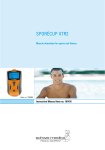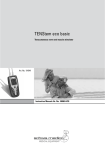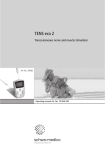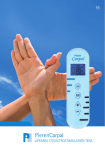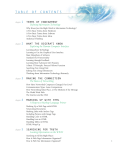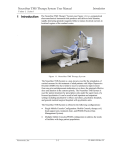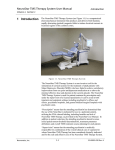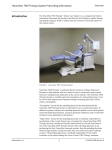Download vasotrain - Harmony Medical
Transcript
VASOTRAIN PORTABLE BIOFEEDBACK EQUIPMENT Instruction Manual 507131 Abbreviated Instructions 1. Insert batteries and plug sensor into the VasoTrain 2. Position the sensor with the help of the headband onto the arterial temporalis (temple); if necessary, seek the pulse at the temple with the finger and place the equipment on this point. Attention! Put sensor area on the skin during this procedure; make sure that the skin is clean and no hair falls between skin and sensor. 3. Switch ON the VasoTrain with z. The device starts in the automatic Setting Mode (CAL). Check the pulse intensity and heart rate on the right display bars after some seconds. If the display shows a low intensity with less than 4 bar segments, renew the sensor’s position at the temple and press P. 4. Start the first phase (calibration) with calm and easy breathing, until the preset CAL Setting Mode is changed to MEA in the display. 5. The VasoTrain now runs in Training Mode MEA. Start the training now. On the left bottom display side you see the running time visible for your orientation. 6. Switch OFF the VasoTrain with z after finishing the training; take off the headband and the sensor. We recommend storing the equipment in the original delivered suitcase. 2 VasoTrain | Instruction Manual Contents 1 2 3 Introduction .................................................................................................................4 Intended use ...............................................................................................................4 Safety Instructions .......................................................................................................5 Precautions.....................................................................................................................5 Relative Contraindications ..............................................................................................5 Side Effects ....................................................................................................................5 4 Device Operation.........................................................................................................5 Switching ON ..................................................................................................................5 Switching OFF ................................................................................................................6 Auto-OFF ........................................................................................................................6 Battery Replacement ......................................................................................................6 Connection plugs at the upper case side ........................................................................6 Display details ................................................................................................................7 5 Operation of VasoTrain ...............................................................................................8 First steps before training / CAL Mode ...........................................................................8 Start of training mode: MEA Mode..................................................................................9 Running training phase (MEA Mode) ..............................................................................9 The use of headphones ..................................................................................................9 Fade out Information ......................................................................................................9 Switch OFF the device ...................................................................................................9 6 Modes .......................................................................................................................10 Setting Mode/Calibration Mode (CAL) ..........................................................................10 Training Mode/Measurement Mode (MEA) ...................................................................10 Setup Mode ..................................................................................................................10 Report Mode .................................................................................................................11 Test Mode ....................................................................................................................11 7 General Advice ..........................................................................................................12 Description of graphical symbols used on the type label ..............................................12 Interaction with other devices .......................................................................................13 Guarantee and Repairs ................................................................................................13 Safety related Checks ..................................................................................................13 Care and Cleaning........................................................................................................13 Batteries .......................................................................................................................13 Storing ..........................................................................................................................14 Product Classification ...................................................................................................14 8 Trouble Shooting .......................................................................................................14 9 Delivery content ........................................................................................................15 10 Technical Data ..........................................................................................................15 VasoTrain | Instruction Manual 3 1 Introduction VasoTrain is a biofeedback training device for the treatment of migraine attacks. The device helps to perform a conscious training during a migraine attack, whereby the widened skull/brain surface vascular structures are narrowed (Vasoconstriction). If a proper technique for this training is applied, the typical migraine attacks may be diminished significantly. What is biofeedback? Biofeedback is a self regulation technique which can be learned and practised with the help of a physiological device. The device helps to display a body process for the patient, such as the activity of a muscle or the width of a vascular structure. As soon as the patient has required a certain routine with the technique, he or she is often in the position to regulate processes alone without the help of the device. Biofeedback therapy is a part method of Cognitive Behavioural Therapy. In contrast to medication, the patient hereby plays an active essential role in the therapy, and thus also controls great parts of the success. What application areas can be treated with the VasoTrain? Vasoconstriction is a well-proven clinical, non-medication method to treat migraine attacks with biofeedback therapy that often results in diminished pain symptoms. Consult your practitioner or therapist prior to the therapy Before starting the biofeedback therapy for Vasoconstriction, your therapist or practitioner shall definitely have diagnosed migraine in your case. At the moment, Vasoconstriction may only make sense for treating migraine attacks. Clinical tests have not clearly shown so far, where other application fields might lay, for instance within other types of headache etc. Your therapist shall also advise and instruct you in the Vasoconstriction. Indication: Migraine How does the Vasoconstriction work within the migraine therapy? A trick is used to display the relative vascular arterial width. A special sensor (Plethysmograph) helps to measure the blood volume of the surface blood vessel beneath the sensor. From this blood volume pulse BVP the relative vessel width is reckoned and shown to the patient as circle symbols and with acoustic tone pitches with the help of the VasoTrain. Hereby, the circles display the width of the vessel, more circles = wide vessel (dilatation), few circles (constriction). 2 Intended use VasoTrain is a biofeedback device used in migraine therapy for prevention of migraine attacks. VasoTrain is especially indicated to be used by patients who feel certain auguries prior to a migraine attack, and for patients who suffer from a circulating migraine in the vicinity of the temples. The device Vaso Train can help to improve the technique of conscious change of blood circulation around the temple arterials (Vasoconstriction) to minimize the migraine attacks. 4 VasoTrain | Instruction Manual 3 Safety Instructions Precautions Do not use the equipment when it has reached contact with water or other liquids. Remove the batteries and let the equipment dry completely prior to reuse. Attention! The VasoTrain must only be used with the original BVP sensor! Never put a plug of another device into the sensor plug connection. The BVP sensor emits low infrared light, which cannot be recognized by the human eye and also is of low intensity and not harmful to the human eye. VasoTrain is a battery-run device with low voltage, which is not emitting electric shocks. Relative Contraindications Psychic disorders and other diseases that may be amplified through the treatment, such as: - Psychoses - Serious neuroses - Serious Obsessive Compulsive Disorders - Serious depression - Therapy resistant seizure disorder (epilepsy) The treatment effect can also be significantly compromised at: - State of disorientation and confusedness - Irrepressible state of anxiety Side Effects - Amplification and aggravation of present discomforts 4 Device Operation Several operating elements of the VasoTrain are displayed in the following. 1. 2. 3. 4. 5. Function key P Function key E Volume Parameter Setting / Sensitivity ON/OFF 2 1 4 3 5 Switching ON Switch ON the VasoTrain with z. If the device switches OFF again with an acoustic signal, the batteries are too low and have to be replaced. VasoTrain | Instruction Manual 5 Switching OFF Switch OFF the VasoTrain with z. All display details shall disappear. Auto-OFF The VasoTrain switches OFF automatically with a signal tone, if not used for more than 5 minutes. Battery Replacement In case the battery status is too low, the device switches OFF automatically with a signal tone. Attention! Never use new and old batteries together, or batteries of different types. Always replace all batteries at once! Dispose the batteries in accordance to the regulations of your country. In case of ignoring these pieces of advice, the batteries’ function can be compromised. 1 2 3 1. Slide back the battery compartment cover at the device backside. The cover shall open after sliding. 2. Take out the three empty Mignon batteries and insert three new ones – properly as shown on the device. Check the polarity of the batteries. The VasoTrain does not operate if batteries are inserted incorrectly. 3. Slide back to close the battery cover. Connection plugs at the upper case side Headphone connection 6 VasoTrain | Instruction Manual BVP sensor connection Connecting the BVP Sensor Plug in the cable and connection of the BVP sensor into the regarding device slot until you feel an interlock. The connection is completed; the cable does not have to be removed after the treatment. To remove the BVP sensor always pull the plug connection, not the cable, as it may be damaged and fall lose from the actual plug. Connecting headphones Headphones (not included in the delivery amount) shall have a 3.5 mm standard stereo connection. Insert the plug properly into the regarding connection slot. Display details Automatic Setting Mode/Calibration Mode (CAL) Battery level Mode Lock symbol Signal intensity Amplifying factor Heart rate Training Mode/Measurement (MEA) Response via circle display Therapy duration Signal intensity VasoTrain | Instruction Manual 7 5 Operation of VasoTrain If not directed differently by the practitioner or therapist, a usual training unit to Vasoconstriction is performed as follows: The patient starts with a relaxation phase of 3-5 minutes, after which he concentrates on narrowing the temple vessels for 3 minutes (constriction, as small display circles as possible) and 1 minute afterwards as relaxation again (dilatation, bigger display circles). This cycle shall be repeated 6 times and be finished with a relaxation phase of 5 minutes at the end. The display circles, and hence the vessel width, hereby is only influenced with relation to certain images and concentration training. Please take care to relax all facial muscles, and breath calmly during the therapy. Further advice regarding the manipulation of the display circles shall be required from the practitioner or therapist. A short manual cannot teach mental training or clinical background methods. We therefore recommend gaining extra information with practitioners specially trained in Vasoconstriction and Biofeedback. Learning with the help of written material, or by experiment on oneself, can surely help, but does not often assure success. First steps before training / CAL Mode Connect the device to the sensor Adjust the headband and the hook-and pile fastener to a tight halt Go beneath the headband and search with the finger for a tactile pulse Place the sensor under the headband at the point of a tactile pulse (see application point in the picture) Attention! Hair and birth marks (moles) between skin and sensor may compromise the measured values of the device. The skin at and near the application area shall be clean. Neckband Sensor Switch ON the VasoStrain with the z key. The device is now in the automatic setting mode. At the start, CAL is shown on the left top display side. Take a relaxing and comfortable position during therapy. We recommend sitting in a comfortable armchair. - - Attention! The BVP sensor is very sensitive. Even small movements like change of pressure, clenching the teeth, talking, swallowing, turning of the head etc. may compromise the device’s given values. Wait a few seconds until the pulse is visible, which is confirmed by a stable signal tone. If the sensor is placed properly, the device can quickly recognize a tactile pulse and the BVP amplitude. The device emits a stable signal tone equal to the beating pulse. The pulse is shown in the numeric display on the bottom right display side. It is normal that a stable signal appears after some moments of unstable values. If, however, no pulse is visible after 8-10 seconds, possibly the signal is too low. In this case try to place the sensor at a position more suitable, or change the pressure of the headband. (If this also does not help, see trouble shooting). 8 VasoTrain | Instruction Manual Attention! To find a proper pulse position takes practice and can take a while. Even position differences of 1 mm can be effective. After every new positioning the sensor needs some time to search a clear signal. The lock symbol signifies that the device is still setting, whereby the device checks the sensor values for exactness. The lock symbol disappears after the setting phase. Start of training mode: MEA Mode The lock symbol disappears if the device receives proper values, and the Training Mode (MEA) begins (standard time 5 seconds, may be set in the Setup Mode resp. Edit Mode). To skip the 5 seconds pause and to start the training manually you can also press the z key. Running training phase (MEA Mode) During the training the ring display shows you the status and alteration of the blood vessel width – in comparison to the starting width – via circles. The display starts with showing 15 rings. A rising number of rings is equal to a widening vessel; a declining number the narrowing. In case of very big variations – independent of patient’s movements – the display shall be adjusted less sensitive. The display scale can be adjusted or equalized within 7 levels. Start of the adjustment level is 3. A higher adjustment is equal to lower device sensitivity, lower adjustments results in a higher sensitivity. Regulate the sensitivity with the right ▼ and ▲ keys. The use of headphones The acoustic signal can also be heard via usual headphones with standard 3.5 mm plugs. The volume is regulated via the left ▼ and ▲ keys. If the volume is set to V 0, the acoustic feedback is switched OFF and is confirmed by the symbol beside. Attention! Do not set the volume too loud at the start; many headphones are set quite high from the beginning and may harm the hearing. Volume Regulation Fade out Information All information, excluding battery status and ring display, can be faded out with the E key, if they irritate. Press E once more to fade in the information again. Switch OFF the device The device VasoTrain can be switched OFF at any time with the z key. VasoTrain | Instruction Manual 9 6 Modes The VasoTrain has 5 working modes: Setting Mode or Calibration Mode (CAL) Training Mode or Measurement Mode (MEA) Setup Mode Report Mode Test Mode (for technicians) Setting Mode/Calibration Mode (CAL) By switching ON the device with the z key, the VasoTrain is put into Setting Mode. This mode can also be reached with the P key. The amplifying factor shown on the display’s left bottom side is chosen by the device and cannot be changed manually. Training Mode/Measurement Mode (MEA) The Training Mode is reached after the usual start of the setting phase. This also happens after pressing the P key (if the lock symbol is faded out) or after a normal start time. Setup Mode Enter the setup mode by simultaneously press and hold the E and the right ▼ key while switching ON the unit with the z key. The mode can also be reached from the Setting Mode by pressing the E key. Volume Automatic starting time Sensitivity Volume Adjustment in Setup Mode The volume set for the acoustic feedback is shown on the left display side. The volume can be adjusted with the left ▼ and ▲ keys. Press the left ▼ key to regulate less volume and the left ▲ key to raise the volume. The range is between 0 and 8, whereby 0 is = signal OFF and 8 the highest volume. Setting the automatic start time The left bottom side of the display shows the automatic start time. Within this variable time period the device remains in the Setting Mode before switching to the Training Mode. Press the right ▼ key to choose a shorter starting time period, and the right ▲ key to choose a longer start time period. The adjustable range is between 5 and 20 seconds. The automatic start time can also be switched OFF; if the value 5 is reached, press the right ▼ key again. The display will show OFF, and the patient shall switch to the Training Mode with P. An automatic switch is now shut down. By pressing the right ▲ key, the automatic start time can be switched ON again. 10 VasoTrain | Instruction Manual Adjustment of Sensitivity On the right bottom side the display shows the range of the device’s sensitivity toward measure variations and external disturbances, but also the reaction factor of the BVP amplitude sensor. By pressing the E key, three levels of intensity (1-3) can be selected, whereby 1 represents the fastest reaction and highest sensitivity, and 3 the slowest. In level 3 the BVP amplitude reaction takes time, but the sensitivity toward external disturbances is the slowest. Report Mode While switching ON the device, press simultaneously the E and the right ▲ key to switch into the Report Mode. Report mode Number of therapy sessions Total therapy time The first details of the Report Mode on the left bottom side show the total therapy time of all sessions in hours and minutes. On the right bottom side the user can see the number of sessions. By pressing the E key the patient reaches the second part of the Report Mode. Here one can see the average time per session in minutes and seconds. On the right bottom side the amount of sessions is displayed. By pressing E again, all data can be deleted. By pressing the P key the Setting Mode is reached again. Test Mode Reach the Test Mode by switching ON the device and simultaneously press the z, the E and left ▼ key. Battery level Ring display Display field 1 Acoustic signal OFF Locking symbol in CAL mode Display field 2 Bar display Display field 3 VasoTrain | Instruction Manual 11 Showing all display symbols Within the first test, all possible graphical symbols are displayed, so they can be checked. Advanced technical device check By pressing the E key the second part of the Test Mode is reached. Hereby the signal transducer, the ring and bar display can be checked. On the left top side the actual software version; and during the editing the volume is shown. The circle symbols may be faded out or in by pressing the right arrow keys. The left arrow keys can fade in and out the bar display – at the same time also adjustment for the volume. The Setting Mode can be reached again by pressing the P key. 7 General Advice Description of graphical symbols used on the type label Attention! Read accompanying documents, especially the user manual! With the labelling of the CE certificate the manufacturer approves that the device meets all necessary requirements from EU directives, and that a conformity evaluation process has been successfully completed. Application unit of Type BF. Warranty for protection against electric shock at adequate leakage current. This symbol is followed by the product’s year of manufacturing. This symbol is followed by the product’s serial number. This symbol is followed by the product’s article respectively order number. This symbol is followed by the product’s LOT charge description. This product is labelled with the Recycling symbol in accordance with the EU directive 2002/96/EG. This means that the product at the end of its working life must be disposed freely at a communal recycling location. Do not dispose it in the household waste. It is an active deed for the benefit of the environment. 12 VasoTrain | Instruction Manual Interaction with other devices Compromising other devices: At appropriate use the VasoTrain has no influence on other medical equipment or electrical devices. Compromising by other devices: The VasoTrain is high-sensitive equipment. The operation of the VasoTrain may be disturbed when used in the vicinity of infrared light, direct light influence, or intensive electromagnetic radiation in lower frequency range. To avoid value variations, please do not use the VasoTrain near the following devices: - Infrared devices (therapy lamps, radiant heaters) - Heat sources (electric heaters, flames or fire places) - Strong and radiating light sources (fluorescent lamps) - Running engines (ventilator, washing machines) - Running devices with strong electromagnetic radiation Guarantee and Repairs The manufacturer affords one year guarantee from date of purchase for the device plus accessories of VasoTrain. The VasoTrain equipment shall only be used with the original BVP sensor. The manufacturer will not assume responsibility for any damage resulting from connecting the BVP sensor and the VasoTrain to other electric equipment. The equipment is delivered without exchange parts. Repairs must only be performed by the manufacturer or persons authorized by the manufacturer. Contact addresses can be found at the end or back of the user manual. The manufacturer will only assume responsibility regarding security and operation safety if the VasoTrain is repaired, newly set or changed by authorized personnel and used in accordance with the user manual. Safety related Checks With economical and commercial use, the VasoTrain shall undergo safety-related checks every 24 months due to § 6 MPBetreibV. Care and Cleaning Do not expose the device to high temperatures, such as leaving it in the car at high temperatures. Also do not expose device and sensor to high humidity, dust, direct sunshine or strong infrared radiation. Clean the cable and device with a moist, lint-free cloth. Make sure that no liquid enters the device. If, however, liquid shall enter the device, take out the batteries and let the device dry completely before reuse. Batteries Use with 3 AA (Mignon) batteries with the VasoTrain. The lowest agreeable voltage is 1.2 V. Battery type Normal (Carbon Zink) Alkaline Accu Alkaline Accu NiCd Accu NiMH Volt Recommendation 1.5 V For non frequent use Recommended 1.5 V For non frequent use 1.2 V For frequent use 1.2 V For frequent use 1.5 V Extension of battery life: Do not leave the device at hot places like in the car at high temperatures. Batteries may get leaky and lose a lot of power at high temperatures via selfdischarge. Use the acoustic feedback only when needed. The energy consumption can be 210 times higher, depending on the adjusted volume. A lower volume setting is needed with headphones. VasoTrain | Instruction Manual 13 Storing For perfect use, the equipment shall be stored in the suitcase under the following conditions: Temperature: 10-30 °C Humidity: 20-90 % Avoid direct light, direct sunshine, and infrared light. Product Classification The VasoTrain is classified as medical product of class I due to the European Directive 93/42/EWG. 8 Trouble Shooting Problem Possible Reason Suggestion for solution The device cannot be switched ON after battery change One or more batteries are inserted incorrectly (wrong poles) Insert the batteries correctly with right poles The device finds no pulse signal; no clear signal tone is audible, or only unstable. Many reasons can be taken into consideration. Please check these possibilities. Infrared radiation or strong light falls on the device (through the patient’s skin) 14 VasoTrain | Instruction Manual Make sure that the sensor has contact with the skin at the touch side. Stay still for 8-10 seconds before checking again. Do not move your head, clench your teeth, or speak. Make sure that no hair lies between skin and sensor Remove all crème and makeup. Check if the sensor is clean. Raise or lessen the pressure onto the arterial by adjusting the headband At the beginning, the correct sensor positioning at the temples and the finding of the pulse takes time and some experience. Changes of 1 mm position can already result in value variations for the signal amplitude. Switch OFF all light sources, avoid direct sunshine 9 Delivery content VasoTrain device BVP Sensor Stand Flexible headband User manual 1.5 V AA Battery 507102 507103 507108 507104 507131 450780 1 piece 1 piece 1 piece 1 piece 1 piece 6 pieces 10 Technical Data VasoTrain unit Highest heart rate recognizable by device Lowest heart rate recognizable by device Required batteries Current consumption without acoustic signal Current consumption with acoustic signal Impedance headphones Dimensions Weight (without batteries) 150 beats per minute 35 beats per minute 3x AA 1.5V 6 mA 10-60 mA 16 Ohm 13.2 x 8.6 x 4.7 cm 140 g BVP Sensor Temperature Drift BVP Sensor Infrared radiation wavelength Axial Radiation intensity of pulse Average Axial Radiation intensity Sensor Frequency 0.5 % per C° 880 nm max 10 mW/sr max 0.3 mW/sr 1 kHz VasoTrain | Instruction Manual 15 Manufacturer Pierenkemper GmbH Hoernsheimer Eck 19 35578 Wetzlar Germany Distributor schwa-medico GmbH Wetzlarer Str. 41-43 35630 Ehringshausen Germany Tel. +49 64438333113 www.schwa-medico.com [email protected] 16 SPORÉCUP XTR2 | Instruction Manual
















